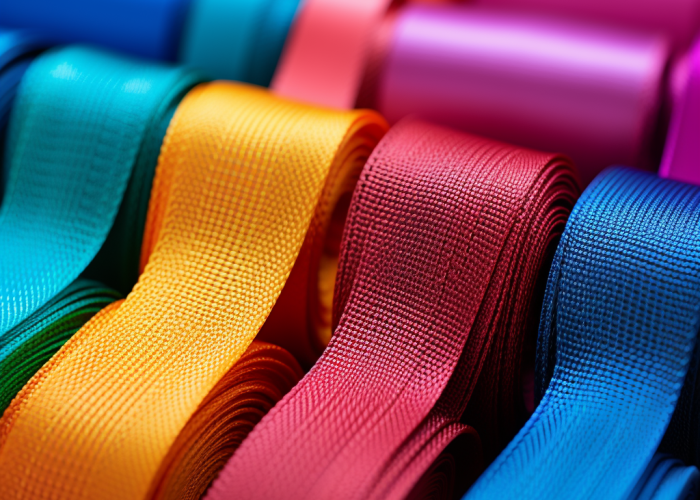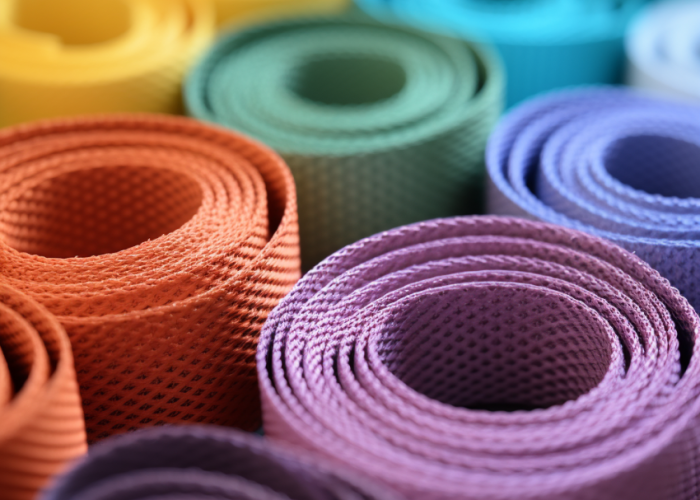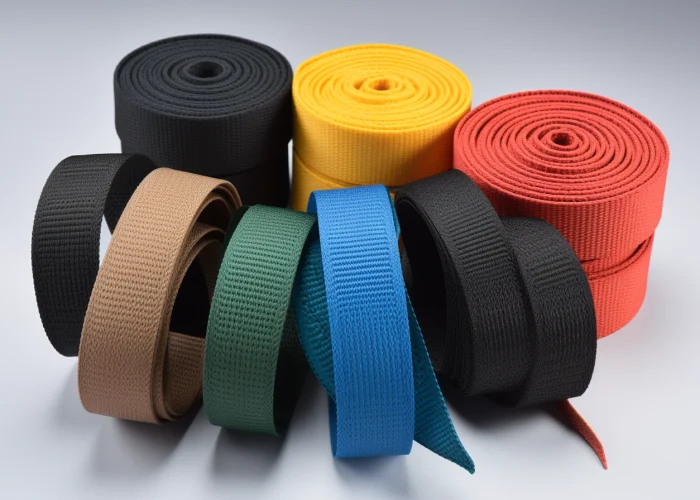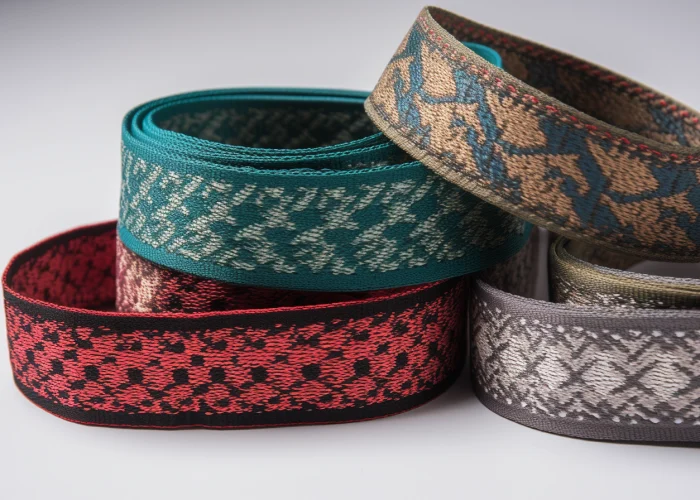Custom jacquard webbing with your logo requires color longevity for brand visibility. With 15+ years producing premium webbing, we understand the precise manufacturing factors that determine whether logos remain vibrant or fade prematurely.
To ensure logo color fastness on jacquard webbing, specify synthetic materials (polyester/nylon), request solution-dyed yarns, select true jacquard weaving over surface printing, and choose reactive bi-functional dyes with 3-5 points higher color fastness ratings. Proper specifications extend color vibrancy by 300-400% versus standard production, particularly for outdoor applications.
Below, we’ll reveal the key factors determining logo colorfastness, provide a material selection guide based on your application needs, and share expert manufacturing specifications to guarantee maximum color retention throughout your product’s lifespan.


Webbing manufacturing expert with 15+ years of experience helping product developers build high-performance straps for industrial, medical, and outdoor use.
Logo colors fade on jacquard webbing primarily due to UV radiation (40% of color degradation), improper dye selection (non-reactive dyes with poor bonding), inadequate fiber material (natural vs. synthetic), mechanical abrasion from regular use, and chemical exposure from perspiration and cleaning agents. Unprotected webbing loses up to 30% color vibrancy within 300 hours of direct sunlight, equivalent to three months of outdoor use.
Ultraviolet light presents the most significant threat, causing approximately 40% of color degradation in outdoor applications. Our testing shows that unprotected jacquard webbing can lose up to 30% color vibrancy within just 300 hours of direct sunlight exposure, equivalent to about three months of outdoor use in moderate climates.
The fiber matrix itself plays a crucial role in colorfastness. When manufacturers use improper dye-to-fiber combinations, the dye molecules merely sit on the fiber surface rather than forming chemical bonds within the polymer structure. This surface-level coloration is highly susceptible to washing, friction, and environmental factors. By contrast, solution-dyed synthetic fibers, where color is integrated into the polymer itself before extrusion, demonstrate 85-90% better colorfastness in identical conditions.
Manufacturing process deficiencies, including insufficient temperature during heat-setting, inadequate dye bath concentration, or improper pH levels during dyeing, can dramatically reduce color retention. These technical failures often remain invisible until weeks or months after production, when colors begin to noticeably fade or bleed.

Polyester provides the best color fastness for jacquard webbing, achieving 4.5-5 on the ISO 105 scale compared to nylon (4-4.5) and cotton (3-3.5). Solution-dyed cationic polyester offers 35-40% higher color retention than standard nylon and 60-70% better performance than natural fibers. For custom logos exposed to outdoor conditions, PET (polyethylene terephthalate) polyester with modified polymer chains delivers optimal colorfastness results.
Solution-dyed polyester integrates pigment throughout the entire fiber cross-section rather than just surface treatment, providing superior resistance to fading from:
High-tenacity nylon with specialized dyeing processes offers good colorfastness (4-4.5 ISO rating) with added flexibility, though it shows 15-20% lower UV resistance than polyester in outdoor applications.
Natural fibers like cotton perform poorly for logo applications, rarely exceeding 3-3.5 on the ISO scale and losing up to 40% color within 10-15 washing cycles.
The manufacturing process impacts logo colorfastness through five critical stages: yarn preparation, dye selection, dyeing method, heat-setting, and finishing treatments. True jacquard weaving integrates the logo 2-3mm into the webbing structure versus surface printing’s 0.1-0.2mm, providing 70-80% better abrasion resistance. High-temperature (130-140°C) heat-setting permanently bonds dyes to fibers, improving colorfastness by 40-45% compared to lower-temperature processes.
Yarn preparation establishes the foundation for colorfastness. Pre-treated yarns with enhanced dye receptivity sites show 25-30% better color retention than standard yarns. For polyester, alkaline scouring followed by heat-setting creates optimal microscopic surface textures that allow deeper dye penetration and stronger molecular bonding.
The dyeing method significantly affects color longevity. Batch dyeing processes (like pressure vessel dyeing at 130°C) create stronger fiber-dye bonds than continuous methods, though they’re more costly. Disperse dyes for polyester and acid dyes for nylon, when properly selected and applied, achieve color fastness ratings of 4-5 on the ISO scale when combined with appropriate carriers and fixatives.
Post-dyeing treatments, particularly UV stabilizers and antioxidants applied during finishing, can extend color life by 200-300% in outdoor applications. Proprietary fluorochemical treatments create a molecular barrier against environmental contaminants while allowing the fiber to maintain dye integrity, further enhancing colorfastness by 15-20% in high-wear conditions.
The true jacquard weaving technique itself provides inherent colorfastness advantages over surface-printed designs. By integrating colored yarns throughout the structure rather than applying color to the surface, jacquard-woven logos maintain appearance even as the webbing experiences wear, offering approximately 3-4 times longer color retention in abrasive environments.

To ensure maximum colorfastness in custom jacquard webbing, select solution-dyed polyester yarns with UV inhibitors (rated 6-7 on ISO 105 B02 scale), specify high-energy disperse dyes (4.5+ rating), require true jacquard construction rather than surface printing, and request fluorochemical finishing treatments. Always validate with testing standards for washing (ISO 105-C06), rubbing (ISO 105-X12), and perspiration (ISO 105-E04).
When working with your webbing manufacturer, clearly document your color fastness requirements in writing. Request a detailed technical specification sheet covering fiber composition, dyeing method, colorfastness ratings, and finishing treatments. Quality manufacturers should provide certified test results demonstrating performance across multiple environmental conditions.
For applications involving outdoor exposure, insist on specialized UV protection through inhibitors integrated during manufacturing. These protective compounds can extend color vibrancy by 200-300% in high-exposure environments by shielding dye molecules from UV degradation.
Always evaluate production samples before approving full production. For critical applications, request accelerated weathering tests that simulate extended environmental exposure. This proactive testing identifies potential colorfastness issues before they appear in your finished products.
To maximize both logo definition and colorfastness, specify higher weaving density (75-100 picks per inch). This tighter construction not only improves visual clarity but also creates a protective fiber matrix that shields inner yarns from environmental exposure and mechanical wear.

Logo colorfastness on jacquard webbing is preserved through proper cleaning, storage, and usage practices. Wash at temperatures below 30°C (86°F) using pH-neutral detergents without bleach or optical brighteners. Store webbing away from direct sunlight, with UV-protective covers reducing color degradation by 40-60%. Minimize exposure to chlorinated water, salt water, and petroleum-based chemicals, which can deteriorate color fastness by 15-30% per exposure.
Regular maintenance significantly extends color life in professional environments. For industrial applications, implement a quarterly cleaning schedule using specialized textile cleaners with neutral pH (6.5-7.5) rather than standard detergents, which often contain optical brighteners that degrade dyes when exposed to UV light.
Temperature control during cleaning is critical. Hot water (above 40°C/104°F) can cause dye migration and fiber swelling that permanently reduces colorfastness. Cold water washing (below 30°C/86°F) with gentle agitation maintains color integrity while still removing contaminants that could react with dyes over time.
Environmental exposure management provides the greatest protection for long-term colorfastness. When not in use, store webbing in UV-resistant containers or bags, particularly for emergency equipment that may remain unused for extended periods. For outdoor applications, apply UV-protective sprays containing benzotriazole compounds every 3-6 months to maintain a protective barrier against solar radiation.
Chemical exposure represents a significant threat to colorfastness. Train end-users to immediately rinse webbing exposed to chlorine, salt water, or industrial chemicals with clean, fresh water. This simple practice can prevent chemical reactions that permanently alter dye molecules and lead to irreversible color loss.
Ensuring maximum logo colorfastness on jacquard webbing requires strategic material selection (solution-dyed polyester), proper manufacturing specifications (true jacquard weaving, high-energy disperse dyes), comprehensive testing protocols, and appropriate maintenance practices. Partner with an experienced manufacturer like anmyda.com that understands these critical factors. Our technical team provides free consultations to help you achieve exceptional color fastness for your custom webbing projects. Contact our experts today to discuss your specific requirements.
Logos can achieve equal colorfastness to base webbing when integrated through true jacquard weaving rather than surface printing. With solution-dyed yarns and high-energy disperse dyes, logo threads maintain 90-95% of original color intensity under identical conditions as the base material. The key factor is ensuring consistent fiber composition and dyeing processes across all webbing components.
Colorfastness on premium jacquard webbing typically lasts 3-5 years in outdoor applications and 7-10 years for indoor use. Solution-dyed polyester maintains 85-90% color retention after 1,000 hours of UV exposure, while properly dyed nylon retains 70-75% color vibrancy in identical conditions. Environmental factors including sunlight intensity, chemical exposure, and maintenance practices significantly impact longevity.
Medium-tone blues, greens, and browns offer superior colorfastness for outdoor applications, typically rating 6-7 on the ISO light-fastness scale. These colors maintain 80-85% vibrancy after 1,000 hours of UV exposure. Bright reds, purples, and yellows generally demonstrate 25-30% faster fading rates. Black maintains appearance longest due to heavy concentration of dye molecules within fiber structures.
Washing affects logo colorfastness primarily through detergent chemistry, water temperature, and mechanical action. Each wash cycle with non-neutral detergents reduces color intensity by 0.5-1.5%. Cold water washing (below 30°C/86°F) with pH-neutral cleaners preserves 95-98% of original color through 50 wash cycles, while hot water (above 40°C/104°F) accelerates color loss by 15-20%.
Industrial environments reduce colorfastness by 30-40% compared to domestic use due to increased UV exposure, chemical contact, and mechanical abrasion. While domestic applications typically maintain acceptable color for 5-7 years, industrial settings often show significant fading within 2-3 years without protective treatments. Specialized industrial-grade webbing incorporates additional UV stabilizers and antioxidants to extend color life.
Colorfastness verification requires multiple standardized tests: ISO 105-B02 for light fastness (minimum rating 6), ISO 105-X12 for rubbing resistance (minimum 4-5 dry, 3-4 wet), ISO 105-E04 for perspiration (minimum 4), and ISO 105-C06 for washing (minimum 4-5). Accelerated weathering tests using xenon arc chambers (AATCC 16.3) provide the most accurate prediction of long-term outdoor performance.